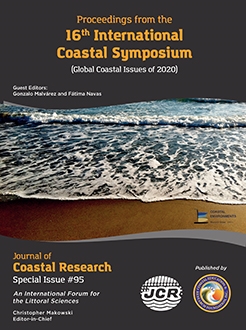Montes, J.; Benavente, J.; Silva, R.; Plomaritis, T.A., and Del Río, L., 2020. Simplified method for the identification of erosion and flooding hazard hotspots on sandy beaches. In: Malvárez, G. and Navas, F. (eds.), Global Coastal Issues of 2020. Journal of Coastal Research, Special Issue No. 95, pp. 1206–1210. Coconut Creek (Florida), ISSN 0749-0208.
The exponential growth in coastal population over the recent decades has intensified the pressure on coastal zones and has placed them on the focus of the scientific community, particularly in the context of climate change. This work presents a reliable method to easily identify current and future hazard hotspots on sandy beaches in monitored coastal areas. Hotspots are defined as areas with high erosion and flooding hazard, which require detailed further study. The methodology is based into the application of WAPO (Wave Propagation On the Coast) model and DSAS (Digital Shoreline Analysis System) tool. WAPO model propagates monochromatic wave trains over a variable bottom and extracts the energy flux on the coast, taking into account refraction, diffraction, shoaling, reflection and energy dissipation. DSAS tool calculates rates of shoreline change from multiple historical shoreline positions. The method was applied in La Atunara beach in the South of Spain, influenced by the presence of anthropic structures and a complex bathymetry. Wave data used in the models were extracted by a joint probability analysis of wave height, period and direction for modal and storm conditions in the zone. Additionally, synthetic cases were generated for assessing climate change impact by modifying mean sea level parameters according to the IPCC scenarios. Results show that this methodology provides a simplified assessment of hotspots that allows focusing on the most vulnerable areas. This avoids the use of more complex and time-consuming models in large areas, allowing efforts to be concentrated on the identified hotspots.





